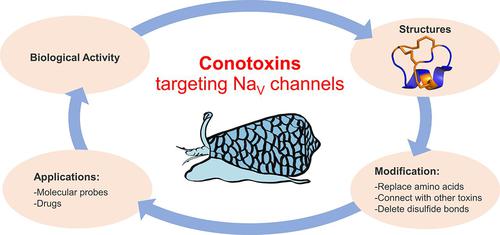当前位置:
X-MOL 学术
›
Pharmacol. Rev.
›
论文详情
Our official English website, www.x-mol.net, welcomes your
feedback! (Note: you will need to create a separate account there.)
Conotoxins Targeting Voltage-Gated Sodium Ion Channels
Pharmacological Reviews ( IF 19.3 ) Pub Date : 2024-09-01 , DOI: 10.1124/pharmrev.123.000923 Shengrong Pei 1 , Nan Wang 1 , Zaoli Mei 1 , Dongting Zhangsun 1 , David J Craik 1 , J Michael McIntosh 1 , Xiaopeng Zhu 2 , Sulan Luo 2
Pharmacological Reviews ( IF 19.3 ) Pub Date : 2024-09-01 , DOI: 10.1124/pharmrev.123.000923 Shengrong Pei 1 , Nan Wang 1 , Zaoli Mei 1 , Dongting Zhangsun 1 , David J Craik 1 , J Michael McIntosh 1 , Xiaopeng Zhu 2 , Sulan Luo 2
Affiliation

|
Voltage-gated sodium (NaV) channels are intimately involved in the generation and transmission of action potentials, and dysfunction of these channels may contribute to nervous system diseases, such as epilepsy, neuropathic pain, psychosis, autism, and cardiac arrhythmia. Many venom peptides selectively act on NaV channels. These include conotoxins, which are neurotoxins secreted by cone snails for prey capture or self-defense but which are also valuable pharmacological tools for the identification and/or treatment of human diseases. Typically, conotoxins contain two or three disulfide bonds, and these internal crossbraces contribute to conotoxins having compact, well defined structures and high stability. Of the conotoxins containing three disulfide bonds, some selectively target mammalian NaV channels and can block, stimulate, or modulate these channels. Such conotoxins have great potential to serve as pharmacological tools for studying the functions and characteristics of NaV channels or as drug leads for neurologic diseases related to NaV channels. Accordingly, discovering or designing conotoxins targeting NaV channels with high potency and selectivity is important. The amino acid sequences, disulfide bond connectivity, and three-dimensional structures are key factors that affect the biological activity of conotoxins, and targeted synthetic modifications of conotoxins can greatly improve their activity and selectivity. This review examines NaV channel–targeted conotoxins, focusing on their structures, activities, and designed modifications, with a view toward expanding their applications.
中文翻译:

针对电压门控钠离子通道的芋螺毒素
电压门控钠(Na V )通道密切参与动作电位的产生和传输,这些通道的功能障碍可能导致神经系统疾病,如癫痫、神经性疼痛、精神病、自闭症和心律失常。许多毒液肽选择性地作用于 Na V通道。其中包括芋螺毒素,它是锥螺分泌的神经毒素,用于捕获猎物或自卫,但也是用于识别和/或治疗人类疾病的有价值的药理学工具。通常,芋螺毒素含有两个或三个二硫键,这些内部交叉键使得芋螺毒素具有紧凑、明确的结构和高稳定性。在含有三个二硫键的芋螺毒素中,一些选择性地靶向哺乳动物 Na V通道,并可以阻断、刺激或调节这些通道。此类芋螺毒素具有作为研究Na V通道功能和特性的药理学工具或作为与Na V通道相关的神经系统疾病的药物先导物的巨大潜力。因此,发现或设计具有高效力和选择性的靶向 Na V通道的芋螺毒素非常重要。芋螺毒素的氨基酸序列、二硫键连通性和三维结构是影响其生物活性的关键因素,对芋螺毒素进行靶向合成修饰可以大大提高其活性和选择性。本综述研究了 Na V通道靶向芋螺毒素,重点关注其结构、活性和设计修饰,以期扩大其应用。
更新日期:2024-08-15
中文翻译:

针对电压门控钠离子通道的芋螺毒素
电压门控钠(Na V )通道密切参与动作电位的产生和传输,这些通道的功能障碍可能导致神经系统疾病,如癫痫、神经性疼痛、精神病、自闭症和心律失常。许多毒液肽选择性地作用于 Na V通道。其中包括芋螺毒素,它是锥螺分泌的神经毒素,用于捕获猎物或自卫,但也是用于识别和/或治疗人类疾病的有价值的药理学工具。通常,芋螺毒素含有两个或三个二硫键,这些内部交叉键使得芋螺毒素具有紧凑、明确的结构和高稳定性。在含有三个二硫键的芋螺毒素中,一些选择性地靶向哺乳动物 Na V通道,并可以阻断、刺激或调节这些通道。此类芋螺毒素具有作为研究Na V通道功能和特性的药理学工具或作为与Na V通道相关的神经系统疾病的药物先导物的巨大潜力。因此,发现或设计具有高效力和选择性的靶向 Na V通道的芋螺毒素非常重要。芋螺毒素的氨基酸序列、二硫键连通性和三维结构是影响其生物活性的关键因素,对芋螺毒素进行靶向合成修饰可以大大提高其活性和选择性。本综述研究了 Na V通道靶向芋螺毒素,重点关注其结构、活性和设计修饰,以期扩大其应用。


















































 京公网安备 11010802027423号
京公网安备 11010802027423号